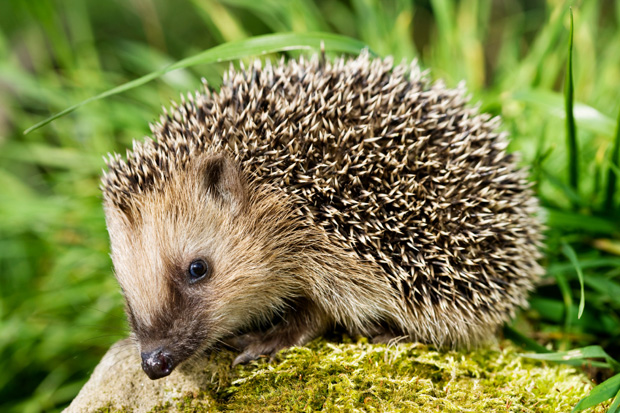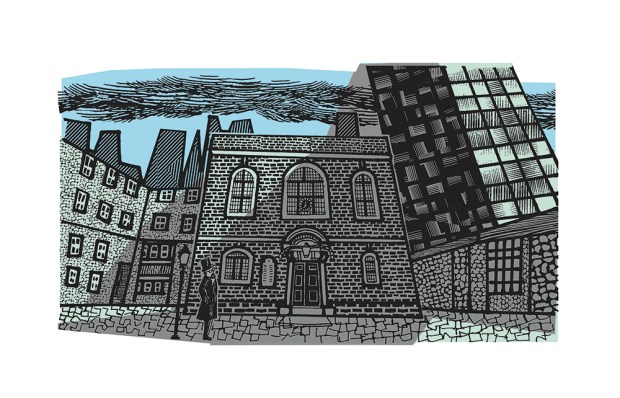Here’s a strange truth about British life: we love a hedgehog. Britain is conspicuously short of an anti-hedgehog lobby. No one runs down a hedgehog with malice. None of us can see a hedgehog crêpe without a twinge of regret. It takes an unfeasibly tough human to look at a hedgehog — even a photograph — without an unbidden softening of the heart.
So if wishes were hedgehogs, our country would be an erinacean paradise. Why, then, have we lost a third of our hedgehogs over the last decade? The British Trust for Ornithology — they’re experts on censusing and go beyond their original remit — cites estimates of 30 million hedgehogs in Britain in the 1950s. This fell to 1.5 million in the 1990s and now stands at fewer than a million.
The problem is not roadkill. Mr Toad and his poop-poop machines take a relatively small responsibility for the decline in British hedgehogs. They haven’t exactly helped, but the real reasons lie elsewhere.
Let’s not talk about blame. Conservation is not about recrimination. It’s about trying to set things right. The best of it lies in what you — you personally — can do to make this happen. We’ll get on to the solutions in a moment, so get ready to salute Solihull — the hedgehog capital of Britain, nothing less. But first the reasons for the decline of a creature universally loved.
We’re not running out of hedgehogs because we flatten them. We’re running out because we’ve taken away their livelihood, their food, their commuting routes, their foraging grounds and their residences. Not on purpose, but humans are infinitely capable of doing bad deeds by accident. To lose one hedgehog can be regarded as a misfortune: to lose 29 million looks like carelessness.
As we managed our countryside with increasing severity after the second world war, aiming to maximise production at the expense of all other considerations, so we tidied up all the scruffy bits, grubbed out miles of hedge — the animals in question are keen on such things, the clue being in the name — and generally converted the countryside into an outdoor food factory.
This involved copious used of pesticides and herbicides, with the result that populations of invertebrates crashed. Real bioabundance — the time when you had to wipe your windscreen every few miles during a summer’s journey, something that those of us who were alive in the 1950s well remember — is a thing of the past.
It follows, then, that creatures who eat invertebrates are somewhat compromised. A hedgehog eats about 100 decent-sized beasts in a night: beetles, slugs and earthworms. If we destroy the places where these creatures can be found and poison them in places where they’re still about, we’re going to run short of hedgehogs.
There are long-term possibilities for hedgehogs that involve gentler management of farmland, under such schemes as Higher Level Stewardship. These can provide untreated field margins and restored hedges for the hogs to savour. But there’s another resource that can also be called in, because of the British delight in hedgehogs.
Gardens. It’s been estimated that our gardens cover more acreage than all the nature reserves in the country. It’s also a fact that hedgehogs are pretty comfortable in suburbia — and for that matter, urbia — so long as we humans are prepared to lend them a paw.
There are two great British vices when it comes to our gardens. The first is to fortify them against invaders with walls and fences. The second is to hammer the lawn with chemicals until it no longer looks like real grass. Both are anti-hedgehog.
Hedgehogs like to roam a couple of kilometres in a night. They can cope with cats and dogs, being prickly customers (their one serious natural predator is the badger). But climbing is not their long suit. They need to move from garden to garden, preferably at ground level. So you can, if you choose, be like the citizens of Solihull and leave or create a hole or two in your fortifications. A gate with a three-inch ground clearance is enough. A five-inch hole is enough to get them through a fence. You can also permit your lawn to support life other than grass.
Simon Thompson of Warwickshire Wildlife Trust is running the Hedgehog Improvement Area scheme with support from the British Hedgehog Preservation Society (of course there is one). ‘It’s a community project,’ he said. ‘It involves the local council and the people who live here.’
So it’s about joining the people up with the wildlife of their town, joining up one garden with another, joining these up with local parks and joining the whole lot up with the hedgehogs. A well-managed golf course is a fine hedgehog habitat. Hedgehogs love a ‘gradient of sward’: that is to say, if you can provide them with fairway, semi-rough and rough they’re happy hedgehogs, so long as you go easy on the herbicides and pesticides.
Earlier this year I saw half a dozen hedgehogs in ten minutes on a nocturnal visit to Alderney golf course. This island has an introduced population of hedgehogs, one that spread from a few individuals brought in during the 1950s — two of them, according to legend, from a Harrods bag. Certainly Harrods used to sell hedgehogs. Fascinating fact: nearly half the Alderney hedgehogs are blond. The population has a recessive gene for leucism, or pale colouring.
If you’re not fortunate enough to live in Solihull, you can still live on Hedgehog Street. This is a project run by the People’s Trust for Endangered Species, and it’s encouraging you at long range to do what people of Solihull are doing. You can register online and report your hedgehog sightings. You can also read about ways to make your garden more attractive to hedgehogs: log-piles, leaf-piles, nectar plants to bring in the invertebrates, fresh water on hot nights.
The fact is that there is a vast amount of goodwill for wildlife in this country: a reservoir of quiet enthusiasm for the whole notion of looking after the natural world. This is not something that gets a high priority in government circles and not something we hear about at election-time. Nevertheless, all things being equal, the British people want the country to be a little bit wilder than it is.
The hedgehogs make that quite clear. Hedgehogs give universal delight without a hint of ambiguity. It follows, then, that direct action can become powerful. It’s possible for Britain to reverse the decline in hedgehogs — and much more of our wild inheritance — if we can only summon up the will. Where the hedgehog leads, so we can follow.
Got something to add? Join the discussion and comment below.
Get 10 issues for just $10
Subscribe to The Spectator Australia today for the next 10 magazine issues, plus full online access, for just $10.
You might disagree with half of it, but you’ll enjoy reading all of it. Try your first month for free, then just $2 a week for the remainder of your first year.














Comments
Don't miss out
Join the conversation with other Spectator Australia readers. Subscribe to leave a comment.
SUBSCRIBEAlready a subscriber? Log in